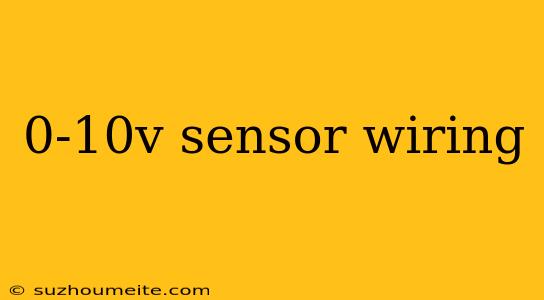0-10V Sensor Wiring: A Comprehensive Guide
Introduction
0-10V sensors are widely used in industrial automation to measure various physical parameters such as temperature, pressure, level, and flow rate. These sensors output a voltage signal that varies between 0 and 10 volts, depending on the measured parameter. Proper wiring of 0-10V sensors is crucial to ensure accurate and reliable measurement data. In this article, we will discuss the basics of 0-10V sensor wiring and provide a step-by-step guide for connecting these sensors to a controller or PLC.
Understanding 0-10V Sensors
A 0-10V sensor typically consists of a sensing element, a signal conditioning circuit, and an output stage. The sensing element converts the physical parameter into an electrical signal, which is then amplified and conditioned by the signal conditioning circuit. The output stage provides a 0-10V voltage signal that is proportional to the measured parameter.
Wiring Requirements
To connect a 0-10V sensor to a controller or PLC, you will need:
- A 2-wire or 3-wire cable, depending on the sensor type
- A power supply voltage (usually 24V DC) to power the sensor
- A shielded cable to minimize electromagnetic interference (EMI)
2-Wire 0-10V Sensor Wiring
A 2-wire 0-10V sensor wiring configuration is commonly used for simple applications. The wiring diagram is as follows:
Pinout:
- Pin 1: Power supply voltage (24V DC)
- Pin 2: Output voltage signal (0-10V)
Wiring Steps:
- Connect the power supply voltage (24V DC) to Pin 1 of the sensor.
- Connect the output voltage signal (0-10V) to the analog input of the controller or PLC (e.g., AI0).
- Ensure that the shielded cable is properly grounded to minimize EMI.
3-Wire 0-10V Sensor Wiring
A 3-wire 0-10V sensor wiring configuration is commonly used for more complex applications. The wiring diagram is as follows:
Pinout:
- Pin 1: Power supply voltage (24V DC)
- Pin 2: Output voltage signal (0-10V)
- Pin 3: Ground (GND)
Wiring Steps:
- Connect the power supply voltage (24V DC) to Pin 1 of the sensor.
- Connect the output voltage signal (0-10V) to the analog input of the controller or PLC (e.g., AI0).
- Connect the ground (GND) wire to the ground terminal of the controller or PLC.
- Ensure that the shielded cable is properly grounded to minimize EMI.
Troubleshooting Tips
- Check the power supply voltage: Ensure that the power supply voltage is within the recommended range (usually 24V DC).
- Verify the output voltage signal: Use a multimeter to verify that the output voltage signal is within the expected range (0-10V).
- Check for electromagnetic interference (EMI): Ensure that the shielded cable is properly grounded to minimize EMI.
Conclusion
In this article, we have discussed the basics of 0-10V sensor wiring and provided a step-by-step guide for connecting these sensors to a controller or PLC. By following these guidelines, you can ensure accurate and reliable measurement data from your 0-10V sensors.
